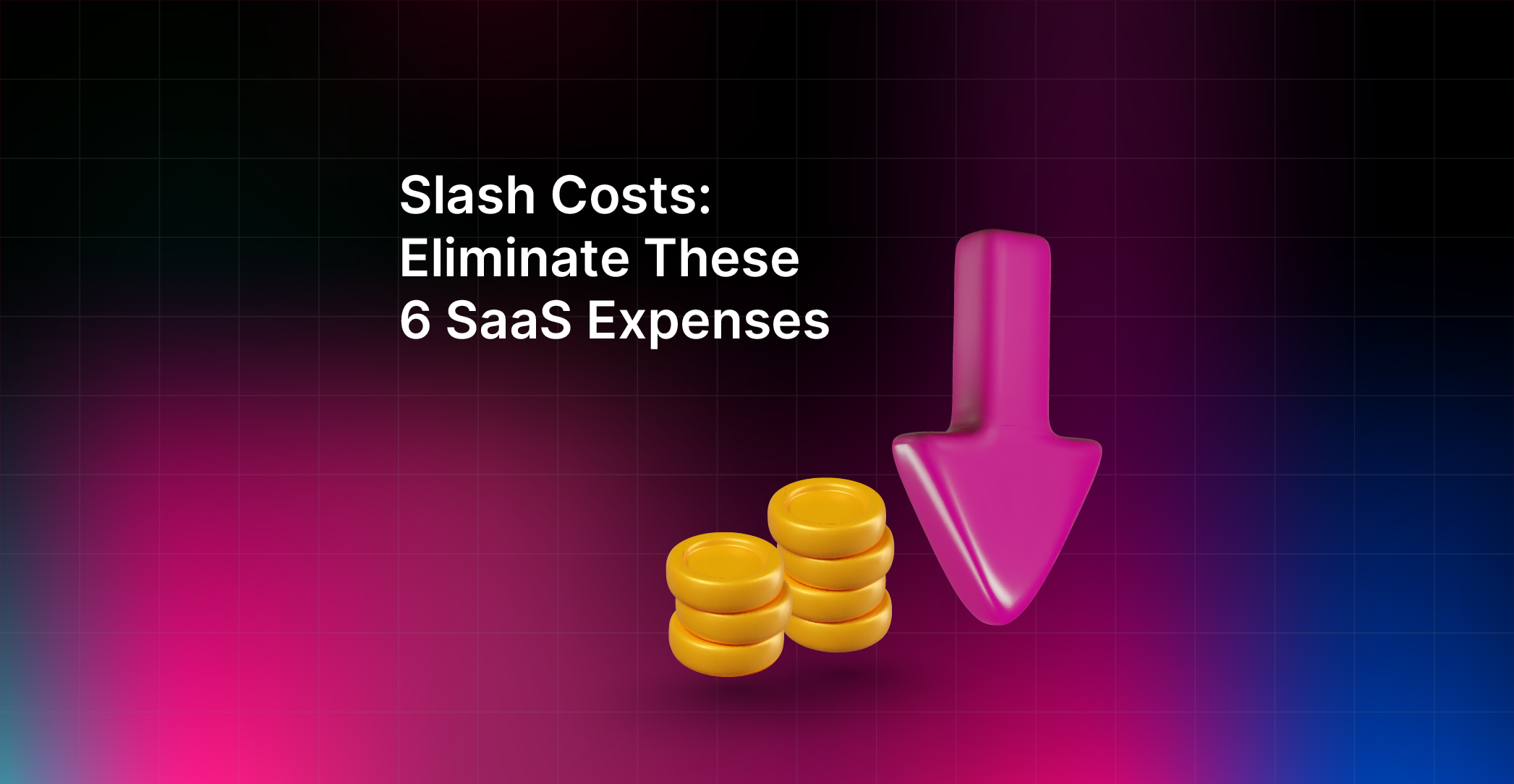

6 Common SaaS Expenses and Strategies to Reduce Them

6 Common SaaS Expenses and Strategies to Reduce Them
What organizations want? Speed and agility. To achieve that, what organizations need? Tools and automation. Everyone is looking for a simpler, faster, smarter..


“The average company now spends over $3,000 per employee every year on SaaS subscriptions,” notes a recent Gartner report. What starts as a few $10 tools can quietly snowball into hundreds of thousands of dollars in hidden costs.
In a time when funding rounds are shrinking and CFOs are under pressure to cut burn, every subscription matters. Unchecked SaaS spending isn’t just wasteful, it directly hits profitability.
This article breaks down six ways your company might be overspending on software and what you can do to fix it.
What Is SaaS Expenses?
SaaS expenses are the costs a business pays for using Software-as-a-Service (SaaS) tools. These include subscription fees, renewals, add-ons, and related costs for cloud-based applications. Managing SaaS expenses helps companies control budgets, reduce waste, and maximize the value of their software investments.
What Are the Different Categories of SaaS Expenses?
SaaS expenses can be grouped into three key categories that affect how costs are reported, managed, and optimized: Operating Expenses (OpEx), Cost of Goods Sold (COGS), and Capital Expenditures (CapEx). Understanding these distinctions helps finance teams plan budgets effectively, track profitability, and make smarter investment decisions.
Operating Expenses (OpEx)
Operating expenses in SaaS refer to the ongoing costs of running day-to-day business operations. These include software subscriptions, employee salaries, marketing automation tools, collaboration platforms, and administrative costs. Since OpEx directly supports operations rather than long-term assets, these expenses are deducted in the same accounting period they occur. Efficient management of operating expenses in SaaS helps maintain cash flow while supporting business growth.
Cost of Goods Sold (COGS)
SaaS COGS covers all direct expenses tied to delivering your software product or service to customers. Typical examples include cloud hosting fees, third-party integrations, customer support, and maintenance costs. These are critical for determining gross margins; a lower COGS indicates higher profitability. Finance leaders track SaaS COGS closely to ensure that scaling user growth doesn’t lead to disproportionate infrastructure costs.
Capital Expenditures (CapEx)
Capital expenditures represent long-term investments in assets that bring value over time, such as building proprietary technology, purchasing servers, or upgrading data infrastructure. Unlike OpEx, CapEx is capitalized, its cost is spread over several years through depreciation. In SaaS, striking the right balance between CapEx and OpEx spending is key to sustainable scaling.
CapEx vs. OpEx in SaaS: A Practical Guide
Understanding how CapEx and OpEx work in SaaS is key to accurate financial planning. Both reflect how a company spends money but they differ in purpose, accounting treatment, and long-term impact. While OpEx in SaaS represents daily operational costs, CapEx in SaaS covers long-term investments that drive growth and innovation.
Comparison Table
How to Optimize Your SaaS Expenses by Category
Managing SaaS costs strategically requires more than cutting subscriptions, it’s about understanding where your money flows and optimizing each category for efficiency and growth. By focusing on COGS optimization and OpEx reduction, finance and procurement teams can build a smarter approach to SaaS expense management that drives measurable savings and long-term sustainability.
Cost of Goods Sold (COGS) Optimization
The first step to optimizing SaaS COGS is identifying all the direct costs tied to delivering your product or service. These often include hosting services (like AWS or GCP), customer support platforms, security tools, and third-party integrations. Since these costs directly impact your gross margins, fine-tuning them can lead to substantial profitability gains.
Effective strategies to optimize SaaS COGS:
- Consolidate overlapping tools: Many organizations use multiple platforms for similar functions CRM, analytics, or ticketing systems. Consolidating them into a single tool reduces duplication and maintenance costs.
- Negotiate vendor contracts proactively: Approach renewals ahead of time to secure multi-year pricing, volume discounts, or bundled deals. Establish benchmark pricing using market data to avoid overpaying.
- Track usage and license efficiency: Regularly monitor seat utilization, usage patterns, and feature adoption. Downgrade or remove unused licenses to cut unnecessary costs.
- Automate renewals and vendor management: Automation tools can alert you before renewals and manage repetitive procurement tasks ensuring no unexpected charges slip through.
Operating Expense (OpEx) Reduction
While COGS relates to customer-facing delivery, reducing SaaS OpEx focuses on internal efficiency and how your teams use tools to operate daily. Operating expenses include employee subscriptions, collaboration tools, analytics, and HR or finance platforms. These costs might seem small individually but can balloon as your organization scales.
Practical steps to reduce SaaS OpEx:
- Centralize SaaS management: Bring all tools under one system of record. A centralized platform provides visibility into subscriptions, costs, and ownership, reducing shadow IT and unnecessary purchases.
- Audit renewals and eliminate redundancy: Perform quarterly audits to identify underused or duplicate tools. Cancel subscriptions that deliver low value or overlap with other solutions.
- Implement spend approval workflows: Establish approval steps for all new software purchases. Require procurement or finance teams to validate the need, usage forecast, and budget before adding any new tools.
- Automate reporting and spend analytics: Use dashboards to visualize spend by department, vendor, and category. Automated reports highlight trends and help detect sudden cost spikes or budget inefficiencies.
- Encourage accountability among teams: Assign tool owners for every subscription. When teams are responsible for their own budgets, they make more thoughtful purchasing decisions.
Top 6 SaaS Expenses and How to Optimize Them
1. Paying the list price
It’s very common these days for employees to buy SaaS tools with their own credit cards and reimburse them to the organization. This means they are paying the list price meant for consumers, not a well-negotiated enterprise price, which can be 20-50% cheaper.
How to cut costs: Centralize SaaS buying without making it a logistical nightmare for employees. Optimize process flows and get the procurement teams to negotiate better deals.
2. Tolerating wastage
Some estimates show that over 55% of apps that organizations subscribe to go unused. This could be because someone bought an app and forgot about it. Or different teams having different tools for the same use case, creating duplicates. Or you signed up for the entire team, but only a small part of them need it. Or licenses for those who are no longer with the team/org continue to remain active because no one bothered canceling etc. These costs are criminal.
How to cut costs: Monitor SaaS ownership and usage in real-time. Conduct regular checks to make sure wastage is curbed to a bare minimum.
3. Setting up auto-renewals
Entering a credit card number and letting the subscription run is like keeping the ticker on all the time. Often, if you haven’t paid close attention to the contract, there might even be a price increase clause that charges you more every subsequent year. This way, you lose the opportunity to negotiate better terms and curb costs.
How to cut costs: Simple. Cancel auto-renewals and negotiate terms for each year. Get into longer-term contracts and pay lesser prices.
4. Confusing pricing models
The most common pricing model is user-based, where you pay $x for every user. Within this, there are tiers like essential, premium, or advanced, with specific features for each tier. However, most SaaS companies won’t let you upgrade for a limited set of users, when one user needs more features, let’s say analytics, you’ll have to upgrade for all users, whether they need analytics or not.
The other pricing model, which is even more confusing, is the usage-based one. You pay for what you use, which is common in cloud infrastructure subscriptions. This makes it unpredictable and opens you up to unwelcome surprises.
How to cut costs: Get expert advice on the exact nature of pricing models.. Forecast usage based on past consumption and negotiate subscriptions within preset limits.
5. Negotiating without the right levers
SaaS negotiations are unlike traditional software buying. Yet, procurement teams don’t have all the information/tools they need to negotiate effectively. They don’t have benchmarks for the prices they’re paying, they are unaware of the right time/place to have negotiation conversations.
How to cut costs: Develop organizational intelligence for SaaS negotiations. Build benchmark pricing models and identify negotiation levers. Create SaaS experts within procurement teams.
6. Not performing ROI evaluations
Even organizations that conduct thorough analysis and comparisons before buying a SaaS tool treat it as a given immediately after. This is a huge mistake. The advantage of SaaS is the low cost of switching providers, it is the responsibility of every CFO to leverage this proactively.
How to cut costs: Track ROI and performance metrics regularly. Conduct audits to identify duplicates. Survey employees to understand satisfaction. Use this information to negotiate future deals. If that sounds like a lot, you’re right. While it’s evident that SaaS expenses need to be controlled, putting that into action can be a steep climb. The good news is: We’ve brought help.
Turning SaaS Overspending into Savings
Unmonitored SaaS expenses can quietly drain your company’s margins. Every unused license, duplicate tool, or unchecked renewal adds up and when budgets tighten, those inefficiencies become impossible to ignore.
A fast-growing SaaS business that partnered with Spendflo to regain control over its spending. Within months, they achieved 3x ROI and over $500K in annual savings by centralizing procurement, tracking renewals, and negotiating better vendor terms.
If your finance or procurement teams still manage software buying through spreadsheets and scattered approvals, you’re leaving significant savings on the table.
- Guaranteed 30% average savings on software and vendor costs.
- Visibility and control across every contract and renewal.
- AI-driven procurement workflows that save time and eliminate errors.
Book a free Spendflo demo today to see how you can cut SaaS expenses and turn cost control into a competitive advantage.
FAQs
What are the common types of SaaS expenses?
SaaS expenses typically fall into three categories: Operating Expenses (OpEx), Cost of Goods Sold (COGS), and Capital Expenditures (CapEx). OpEx includes everyday operational tools like HR, finance, and marketing software. COGS covers costs directly tied to delivering your product or service such as hosting, customer support, or third-party integrations. CapEx includes long-term investments like developing proprietary technology or upgrading infrastructure. Understanding these categories helps finance teams manage budgets and improve ROI.
What is SaaS spend management?
SaaS spend management is the process of tracking, controlling, and optimizing all software-related expenses across an organization. It involves gaining visibility into subscriptions, renewals, usage, and vendor contracts to prevent waste and reduce costs. Effective SaaS spend management ensures that every tool delivers value, aligns with business goals, and fits within budget helping companies avoid overspending while maximizing the benefits of their software stack.
What is "Shadow IT" and how does it relate to SaaS expenses
“Shadow IT” refers to software or applications used within a company without the approval or knowledge of the IT or procurement teams. Employees often adopt these tools for convenience, but this leads to hidden costs, duplicate subscriptions, and potential security risks. Shadow IT directly inflates SaaS expenses because these unauthorized tools escape budget reviews and audits. Identifying and consolidating them is essential to maintaining cost efficiency and compliance across the organization.















.png)




.png)





.avif)





